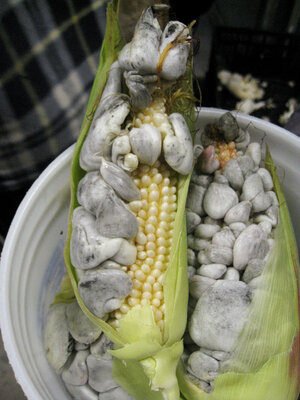Corn smut a delicacy? Well, if truffles can be, why not?
 Jill Neimark, the salt, 24 August 2015,
Scourge No More: Chefs Invite Corn Fungus To The Plate,
Jill Neimark, the salt, 24 August 2015,
Scourge No More: Chefs Invite Corn Fungus To The Plate,
One evening last July, Nat Bradford walked along rows of White Bolita Mexican corn at his Sumter, S.C., farm, and nearly wept. All 1,400 of the corn plants had been overtaken almost overnight by corn smut, recalls Bradford, who’s also a landscape architect. The smut, from a fungus called Ustilago maydis, literally transforms each corn kernel into a bulbous, bulging bluish-grey gall. It is naturally present in the soil and can be lofted easily into the air and onto plants.
Smut is considered a scourge by most U.S. farmers, and it goes by the nickname “devil’s corn.” Just one discolored kernel typically renders an ear completely unsellable….
Yep, that’s the way we’ve usually considered it. But keep reading:
He asked Bradford to harvest the smut by hand and bring it to Charleston, where Brock prepared tacos with it. “I love when nature throws you a curveball, and it tastes like this,” says Brock. “It’s insanely delicious and luxurious, like black truffles.”
Brock isn’t alone in his view—there has been a dedicated corn smut underground for decades in America, even as corn growers and the government have spent millions trying to eradicate it, forbid imports of it and breed strains of corn resistant to it.
But in Mexico, corn smut is known as huitlacoche, and it’s long been a delicacy . Traditionally, families would walk miles among the cornstalks just to gather a basket of ears infected with this distant relative of mushrooms. It is still sold fresh at markets and used as a filling in tacos, quesadillas and soups. “It may have been ambrosia of the Aztec gods with an inky, mushroomy flavor that is almost impossible to describe,” wrote Diana Kennedy, the “Julia Child of Mexico,” in her 1986 book The Cuisines of Mexico.
Cuitlacoche grows when a drop of rain seeps into a husk of corn. In Mexico’s corn-loving culture, the quasi-mushroom also provides nutrition: high amounts of the essential amino acid lysine that’s absent in corn, as well as lots of fiber and protein. Together, corn and huitlacoche make a complete protein meal.
I will pass on the Ustilago maydis, since I’m allergic to molds and many fungi. But maybe it’s worth considering as a product.
Owed to Thom Kirkpatrick.
-jsq
Short Link: